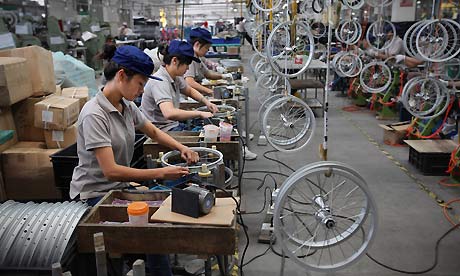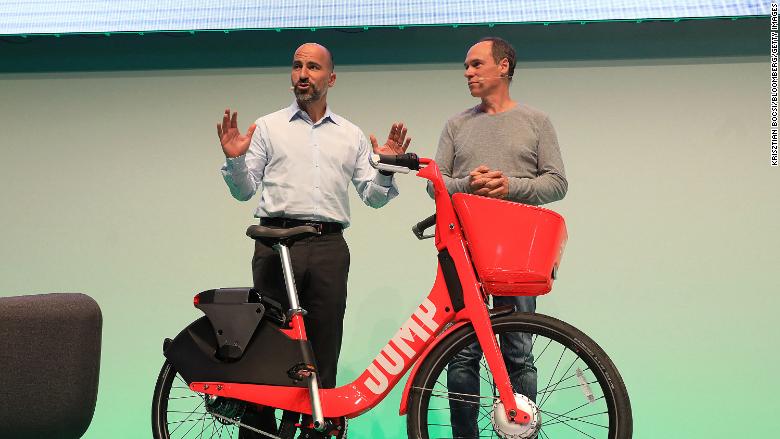The moment anyone with power uses the word "protect", I reach for my trusty frame pump. Not only does it get my tires up to pressure in a pinch, it's great for swatting away stray dogs and other threats and nuisances.
You see, I've come to realize that any powerful person who thinks he or she can "protect" anyone or anything he or she hasn't met is delusional or lying.
And so it is with El Cheeto Grande. He's passed another round of tariffs because he's, once again, got his knickers in a twist over China.
Of course, the tariffs will not "protect" American industries because...well, they don't exist anymore, if indeed they ever did.
(Besides, all you have to do is look at Smoot-Hawley to realize that tariffs almost never have their intended consequences. But that would be the subject of, not just another post, but another blog--or a book!)
To wit: Back in the Clinton administration, I tried to put together an all-American bike. Of course, I did it on paper. Frames and forks weren't hard to find, though they were almost always more expensive than imports. Ditto for the Chris King headset, as great as it is. Yankee-made handlebars, stems and seatposts were available, but they were mainly "boutique" items.
The other components, on the other hand, were a lot more difficult to find. Sun was making its rims, and Wheelsmith its spokes, in the USA. And there were a number of small companies fabricating hubs here in the USA, such as Phil Wood and Chris King. They, of course, cost far more than even Dura Ace or Record stuff, but at least they kept my exercise going.
That is, until I tried to find tires. To my knowledge, none have been made here since Carlisle ceased production, apparently some time in the early '80's. Goodyear, Firestone and other rubber companies had exited the non-motorized trade long before that.
OK, I thought: The tires are just one part (or two components, depending on how you look at it.). Surely, I could make the rest of the bike into a Yankee Doodle Dandy.
Then I tried to put together a drivetrain. Mind you, this was during the days when it seemed every 25-year-old in California or Colorado who had access to a lathe was turning out lightweight (and very expensive) cranksets and derailleurs in a rainbow of colors. I thought cassettes would be my next hurdle but, as it turned out, some company--in Massachusetts, I think--was making titanium bits--including cassettes.
Eight speeds were the standard at that time. If you remember anything about Shimano's 8-speed equipment, you knew that not everything was interchangeable between gruppos. Namely, a Dura Ace hub would take only Dura Ace cassettes--not Ultegra, 105 or any other. Turned out, the titanium cassette was made only for Dura Ace--which, I supposed, made sense, given what Dura Ace and titanium equipment cost.
(Aside: Shimano's 9-speed stuff was interchangeable. So Dura Ace hubs could take Ultegra cassettes, which weighed a bit more but cost about half as much. And the standard 9-speed Dura Ace cassette was made of titanium, which pre-empted aftermarket stuff.)
But there were no chains made stateside. Back in the day, the baloon-tired coaster brake bikes had American chains; however, as far as I know, no derailleur-compatible chain has ever been made here. Nor were any pedals, save for the rubber-block variety found on said wide-tire "bombers".
Oh--and there were no American-made saddles.
Today it would be even more difficult to put together an all- (or even mostly-) American machine. And almost very few bike accessories are made here. Yet they are all subject to tariffs.
And it's all but impossible to find some items made anywhere besides China. Almost anything electronic--lights, computers and the like--come from Cathay.
So do helmets. Interestingly, they have been exempted from tariffs. It's ironic when you realize that one of the rationales for the tariffs is to protect against intellectual property theft--and nearly all helmets are designed in the US!
Of course, bicycles are far from the only things to be affected by the tariffs. I'm not sure I'd want to be a farmer who raises corn, soybeans or hogs right about now. But I have yet to hear anyone explain how any job or industry will be "protected" in this country.
You see, I've come to realize that any powerful person who thinks he or she can "protect" anyone or anything he or she hasn't met is delusional or lying.
And so it is with El Cheeto Grande. He's passed another round of tariffs because he's, once again, got his knickers in a twist over China.
Of course, the tariffs will not "protect" American industries because...well, they don't exist anymore, if indeed they ever did.
 |
(Besides, all you have to do is look at Smoot-Hawley to realize that tariffs almost never have their intended consequences. But that would be the subject of, not just another post, but another blog--or a book!)
To wit: Back in the Clinton administration, I tried to put together an all-American bike. Of course, I did it on paper. Frames and forks weren't hard to find, though they were almost always more expensive than imports. Ditto for the Chris King headset, as great as it is. Yankee-made handlebars, stems and seatposts were available, but they were mainly "boutique" items.
The other components, on the other hand, were a lot more difficult to find. Sun was making its rims, and Wheelsmith its spokes, in the USA. And there were a number of small companies fabricating hubs here in the USA, such as Phil Wood and Chris King. They, of course, cost far more than even Dura Ace or Record stuff, but at least they kept my exercise going.
That is, until I tried to find tires. To my knowledge, none have been made here since Carlisle ceased production, apparently some time in the early '80's. Goodyear, Firestone and other rubber companies had exited the non-motorized trade long before that.
OK, I thought: The tires are just one part (or two components, depending on how you look at it.). Surely, I could make the rest of the bike into a Yankee Doodle Dandy.
Then I tried to put together a drivetrain. Mind you, this was during the days when it seemed every 25-year-old in California or Colorado who had access to a lathe was turning out lightweight (and very expensive) cranksets and derailleurs in a rainbow of colors. I thought cassettes would be my next hurdle but, as it turned out, some company--in Massachusetts, I think--was making titanium bits--including cassettes.
Eight speeds were the standard at that time. If you remember anything about Shimano's 8-speed equipment, you knew that not everything was interchangeable between gruppos. Namely, a Dura Ace hub would take only Dura Ace cassettes--not Ultegra, 105 or any other. Turned out, the titanium cassette was made only for Dura Ace--which, I supposed, made sense, given what Dura Ace and titanium equipment cost.
(Aside: Shimano's 9-speed stuff was interchangeable. So Dura Ace hubs could take Ultegra cassettes, which weighed a bit more but cost about half as much. And the standard 9-speed Dura Ace cassette was made of titanium, which pre-empted aftermarket stuff.)
But there were no chains made stateside. Back in the day, the baloon-tired coaster brake bikes had American chains; however, as far as I know, no derailleur-compatible chain has ever been made here. Nor were any pedals, save for the rubber-block variety found on said wide-tire "bombers".
Oh--and there were no American-made saddles.
Today it would be even more difficult to put together an all- (or even mostly-) American machine. And almost very few bike accessories are made here. Yet they are all subject to tariffs.
And it's all but impossible to find some items made anywhere besides China. Almost anything electronic--lights, computers and the like--come from Cathay.
So do helmets. Interestingly, they have been exempted from tariffs. It's ironic when you realize that one of the rationales for the tariffs is to protect against intellectual property theft--and nearly all helmets are designed in the US!
Of course, bicycles are far from the only things to be affected by the tariffs. I'm not sure I'd want to be a farmer who raises corn, soybeans or hogs right about now. But I have yet to hear anyone explain how any job or industry will be "protected" in this country.

















